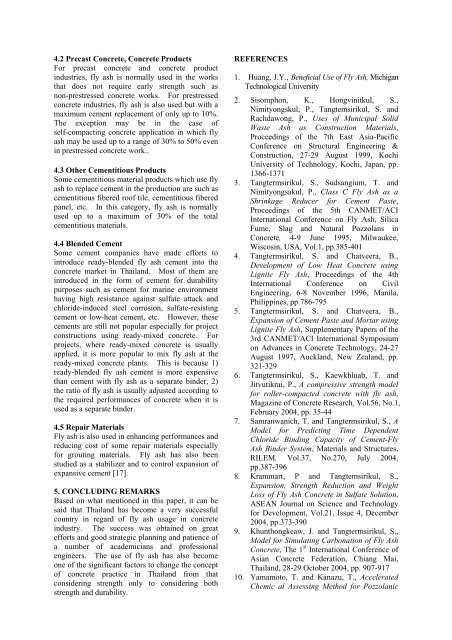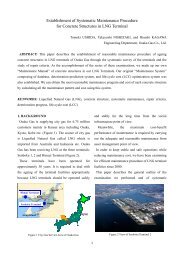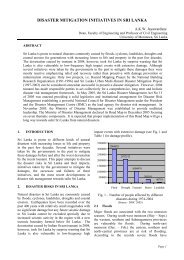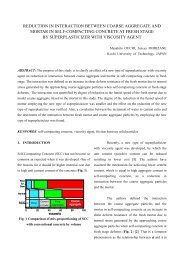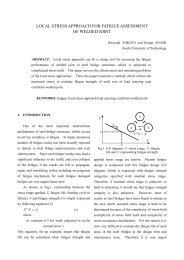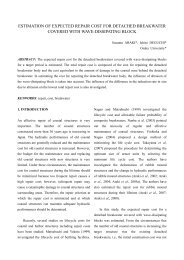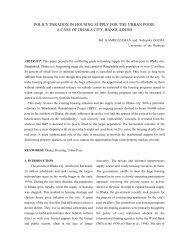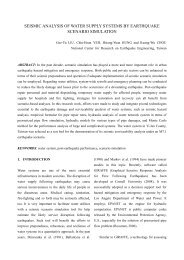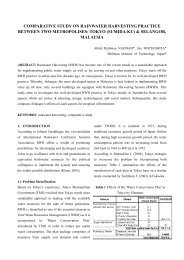DEVELOPMENT OF FLY ASH USAGE IN THAILAND
DEVELOPMENT OF FLY ASH USAGE IN THAILAND
DEVELOPMENT OF FLY ASH USAGE IN THAILAND
Create successful ePaper yourself
Turn your PDF publications into a flip-book with our unique Google optimized e-Paper software.
4.2 Precast Concrete, Concrete Products<br />
For precast concrete and concrete product<br />
industries, fly ash is normally used in the works<br />
that does not require early strength such as<br />
non-prestressed concrete works. For prestressed<br />
concrete industries, fly ash is also used but with a<br />
maximum cement replacement of only up to 10%.<br />
The exception may be in the case of<br />
self-compacting concrete application in which fly<br />
ash may be used up to a range of 30% to 50% even<br />
in prestressed concrete work..<br />
4.3 Other Cementitious Products<br />
Some cementitious material products which use fly<br />
ash to replace cement in the production are such as<br />
cementitious fibered roof tile, cementitious fibered<br />
panel, etc. In this category, fly ash is normally<br />
used up to a maximum of 30% of the total<br />
cementitious materials.<br />
4.4 Blended Cement<br />
Some cement companies have made efforts to<br />
introduce ready-blended fly ash cement into the<br />
concrete market in Thailand. Most of them are<br />
introduced in the form of cement for durability<br />
purposes such as cement for marine environment<br />
having high resistance against sulfate attack and<br />
chloride-induced steel corrosion, sulfate-resisting<br />
cement or low-heat cement, etc. However, these<br />
cements are still not popular especially for project<br />
constructions using ready-mixed concrete. For<br />
projects, where ready-mixed concrete is usually<br />
applied, it is more popular to mix fly ash at the<br />
ready-mixed concrete plants. This is because 1)<br />
ready-blended fly ash cement is more expensive<br />
than cement with fly ash as a separate binder, 2)<br />
the ratio of fly ash is usually adjusted according to<br />
the required performances of concrete when it is<br />
used as a separate binder.<br />
4.5 Repair Materials<br />
Fly ash is also used in enhancing performances and<br />
reducing cost of some repair materials especially<br />
for grouting materials. Fly ash has also been<br />
studied as a stabilizer and to control expansion of<br />
expansive cement [17].<br />
5. CONCLUD<strong>IN</strong>G REMARKS<br />
Based on what mentioned in this paper, it can be<br />
said that Thailand has become a very successful<br />
country in regard of fly ash usage in concrete<br />
industry. The success was obtained on great<br />
efforts and good strategic planning and patience of<br />
a number of academicians and professional<br />
engineers. The use of fly ash has also become<br />
one of the significant factors to change the concept<br />
of concrete practice in Thailand from that<br />
considering strength only to considering both<br />
strength and durability.<br />
REFERENCES<br />
1. Huang, J.Y., Beneficial Use of Fly Ash, Michigan<br />
Technological University<br />
2. Sisomphon, K., Hongvinitkul, S.,<br />
Nimityongskul, P., Tangtemsirikul, S. and<br />
Rachdawong, P., Uses of Municipal Solid<br />
Waste Ash as Construction Materials,<br />
Proceedings of the 7th East Asia-Pacific<br />
Conference on Structural Engineering &<br />
Construction, 27-29 August 1999, Kochi<br />
University of Technology, Kochi, Japan, pp.<br />
1366-1371<br />
3. Tangtermsirikul, S., Sudsangium, T. and<br />
Nimityongsakul, P., Class C Fly Ash as a<br />
Shrinkage Reducer for Cement Paste,<br />
Proceedings of the 5th CANMET/ACI<br />
International Conference on Fly Ash, Silica<br />
Fume, Slag and Natural Pozzolans in<br />
Concrete, 4-9 June 1995, Milwaukee,<br />
Wiscosin, USA, Vol.1, pp.385-401<br />
4. Tangtermsirikul, S. and Chatveera, B.,<br />
Development of Low Heat Concrete using<br />
Lignite Fly Ash, Proceedings of the 4th<br />
International Conference on Civil<br />
Engineering, 6-8 November 1996, Manila,<br />
Philippines, pp.786-795<br />
5. Tangtermsirikul, S. and Chatveera, B.,<br />
Expansion of Cement Paste and Mortar using<br />
Lignite Fly Ash, Supplementary Papers of the<br />
3rd CANMET/ACI International Symposium<br />
on Advances in Concrete Technology, 24-27<br />
August 1997, Auckland, New Zealand, pp.<br />
321-329<br />
6. Tangtermsirikul, S., Kaewkhluab, T. and<br />
Jitvutikrai, P., A compressive strength model<br />
for roller-compacted concrete with fly ash,<br />
Magazine of Concrete Research, Vol.56, No.1,<br />
February 2004, pp. 35-44<br />
7. Samranwanich, T. and Tangtermsirikul, S., A<br />
Model for Predicting Time Dependent<br />
Chloride Binding Capacity of Cement-Fly<br />
Ash Binder System, Materials and Structures,<br />
RILEM, Vol.37, No.270, July 2004,<br />
pp.387-396<br />
8. Krammart, P and Tangtemsirikul, S.,<br />
Expansion, Strength Reduction and Weight<br />
Loss of Fly Ash Concrete in Sulfate Solution,<br />
ASEAN Journal on Science and Technology<br />
for Development, Vol.21, Issue 4, December<br />
2004, pp.373-390<br />
9. Khunthongkeaw, J. and Tangtermsirikul, S.,<br />
Model for Simulating Carbonation of Fly Ash<br />
Concrete, The 1 st International Conference of<br />
Asian Concrete Federation, Chiang Mai,<br />
Thailand, 28-29 October 2004, pp. 907-917<br />
10. Yamamoto, T. and Kanazu, T., Accelerated<br />
Chemic al Assessing Method for Pozzolanic


